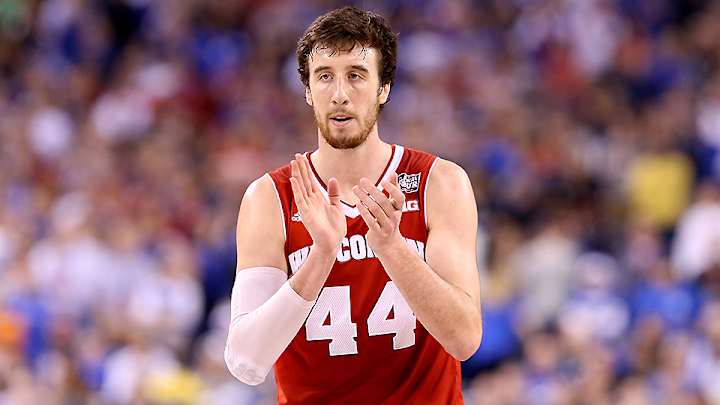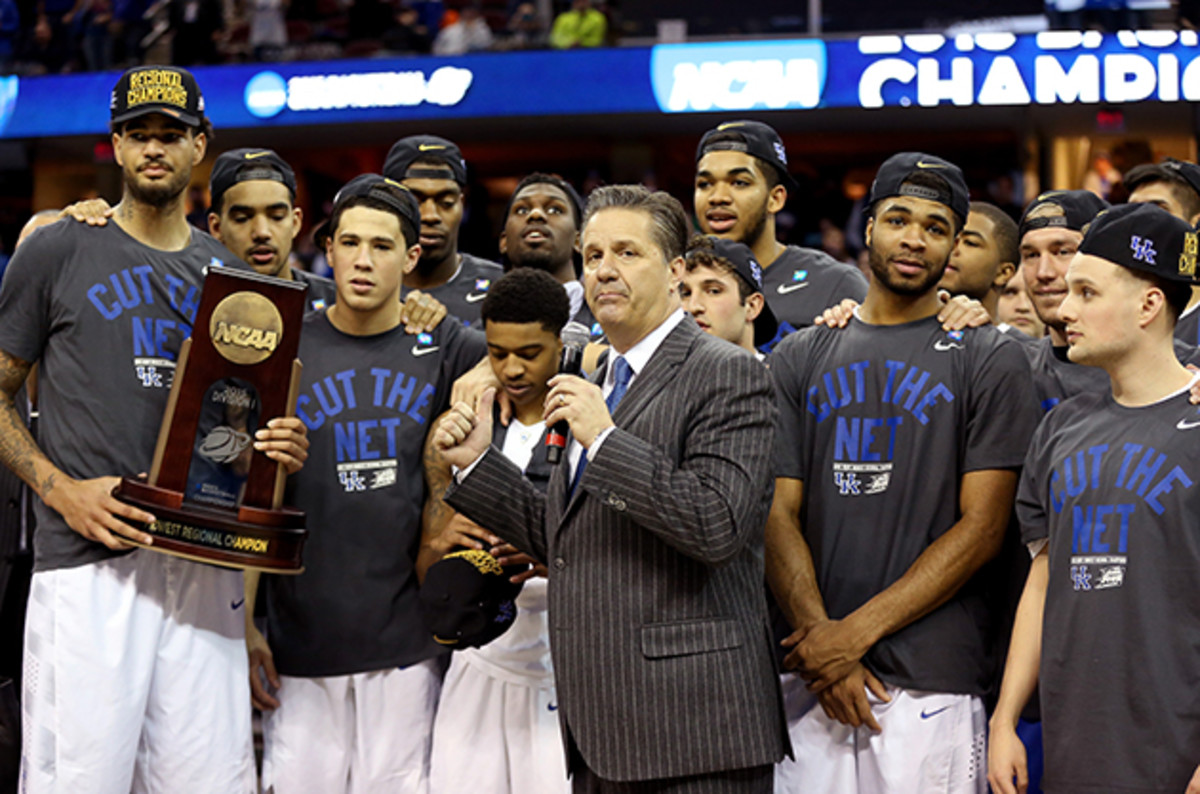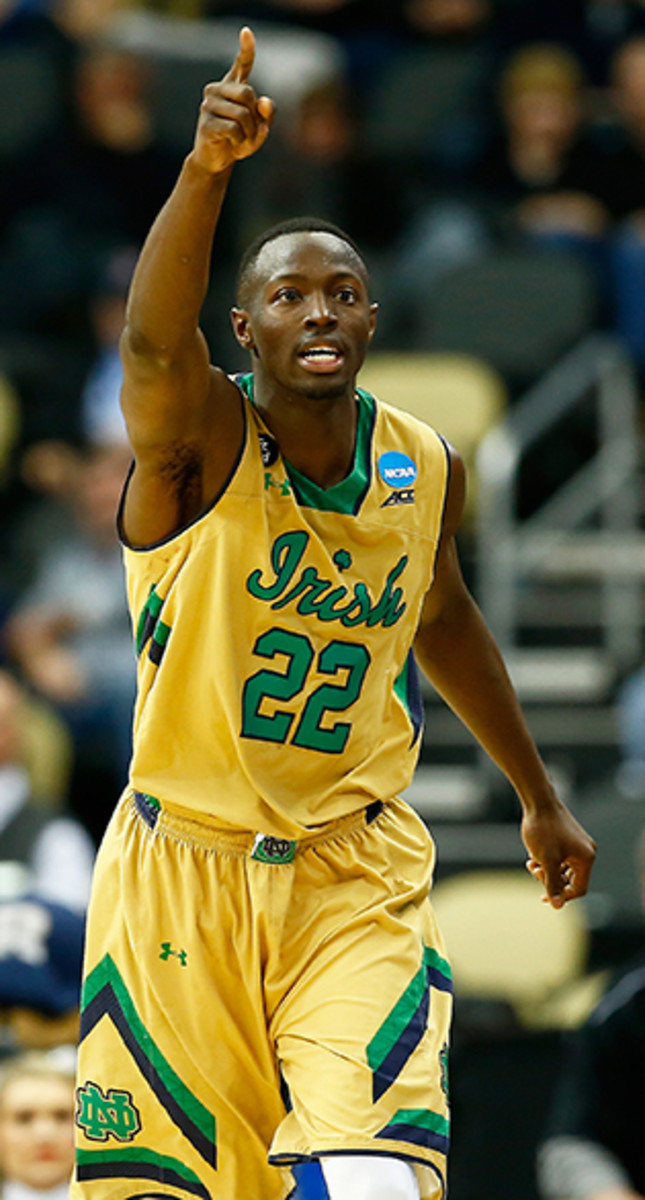Frank Kaminsky, Wisconsin, Duke clean up in first-ever Effy Awards

SI presents The Effys: the least ambiguous and least prestigious postseason awards in college basketball. Every award is based on efficiency or other advanced metrics. No voting—just analytics.
(For the first three seasons, these were called the Data-Based Awards, which also made them the least-cool-sounding honors in the sport. That has been rectified, or at least I hope so. Past editions: 2013-14, 2012-13, 2011-12, 2011-12)
Team Awards
Efficiency Kings: Wisconsin
Kentucky had the most efficient team overall, but the Badgers get the nod here for a historic achievement. They had the greatest offense of what I call the efficiency era, which dates back to the 2002 launch of statistician Ken Pomeroy's website. Wisconsin was a schedule-adjusted 25.9 points per 100 possessions better than this season's D-I average offense, a margin that blows away the other great scoring attacks since 2002:
Most Efficient Offenses, 2002-present
rank | team | adj. oFF. eFF. | D-I AVG. OFFENSE | pts/100p above avg. |
|---|---|---|---|---|
1 | Wisconsin (2015) | 127.9 | 102.0 | 25.9 |
2 | Missouri (2012) | 123.9 | 100.8 | 23.1 |
3 | Wake Forest (2005) | 124.0 | 101.0 | 23.0 |
4 | Ohio State (2011) | 123.3 | 101.3 | 22.0 |
5 | North Carolina (2009) | 122.4 | 101.1 | 21.3 |
6 | Notre Dame (2015) | 123.2 | 102.0 | 21.2 |
7 | North Carolina (2005) | 121.9 | 101.0 | 20.9 |
8 | Kentucky (2012) | 121.3 | 100.8 | 20.5 |
9 | Wake Forest (2004) | 121.0 | 100.8 | 20.2 |
10 | Michigan (2013) | 120.3 | 100.4 | 19.9 |
Soon-to-be first-round picks Frank Kaminsky and Sam Dekker anchored the Badgers' short rotation of high-accuracy, low-turnover scorers, and they carved up two of the nation's elite defenses (Kentucky and Arizona) to reach the national-title game. Wisconsin scoring 1.23 points per possession against Kentucky, which entered the Final Four as the stingiest defense of college basketball's modern era, was a monumental feat in itself. But what the Badgers did over the course of a 40-game season was even bigger: They set a new gold standard for efficient offense.
Runner-up: Kentucky, for its rim-protecting, switching, super-deep defense. Although the Wildcats' late slippage against Wisconsin and Notre Dame kept them from becoming the greatest D of the modern era, they delivered plenty of devastating performances, in particular their early-season asphyxiations of Kansas and UCLA, and their Sweet 16 double-up of West Virginia.
Best defensive NCAA tournament (min. four games played): Duke
Virginia, UNC, Kentucky lead Way-Too-Early College Basketball Top 25
The determining metric here is Net Efficiency Margin, which was developed by Crashing The Dance's Andy Cox to compare a team's efficiency against the expected performance of a D-I average squad in the same situation. Duke was no defensive juggernaut coming into the NCAAs—it was more of a team just trying to get by—but it strung together six high-level defensive games to win the national title. The Blue Devils' D, which switched between man-to-man and an assortment of zones, was 20.1 points per 100 possessions better than the D-I average expectation during the NCAAs. It was also the only defense that derailed Wisconsin in the tournament, by employing the surprisingly effective matchups of Matt Jones on Dekker and Amile Jefferson on Kaminsky.
The top four defenses in the tourney, by NEM:
1. Duke: 6 games, -20.1 points per 100 possessions better than D-I average
2. Kentucky: 5 games, -18.9
3. Michigan State: 5 games, -10.2
4. Louisville: 4 games, -8.2
Best offensive NCAA tournament (min. four games played): Wisconsin
Badgers coach Bo Ryan was nominated for the Basketball Hall of Fame's Class of 2015 but didn't get an induction nod. Winning multiple Effys should make up for that—and bolster a résumé that's already Hall-worthy. With their mastery of shot selection and extreme turnover-avoidance, the Badgers shredded the first five defenses they faced in the NCAAs, scoring 35.5 points per 100 possessions better than the D-I average expectation. Duke made Wisconsin look human in the title game, but UW's offense still led the tourney in NEM by a wide margin.
The top four offenses n the tourney, by NEM:
1. Wisconsin: 6 games, +31.5 points per 100 possessions better than D-I average
2. Arizona: 4 games, +24.5
3. Duke: 6 games, +22.8
4. Notre Dame: 4 games, +21.7
Whistle Wizards: Wisconsin
No team enjoyed a bigger advantage from the stripe than Wisconsin, which averaged 24.3 free throws made per 100 possessions while allowing just 13.3. Ryan emphasizes conservative, hands-off, foul-free D and generally believes they've never done anything to warrant a whistle. On offense, Kaminsky and Nigel Hayes were adept at drawing shooting fouls near the basket, and as a team they ranked 12th nationally in free-throw percentage at 76.3. Aside from the Badgers' national title-game loss, during which Ryan nearly imploded while watching Duke build a 16-6 advantage on free throws, they won the whistle war.
Top Five Free-Throw Margins
rank | team | FTs made/100p | fts allowed/100p | margin |
|---|---|---|---|---|
1 | Wisconsin | 24.3 | 13.3 | +11.0 |
2 | Maryland | 25.6 | 16.1 | +9.5 |
3 | Kentucky | 26.5 | 17.2 | +9.4 |
4 | Duke | 23.0 | 14.5 | +8.6 |
5 | Northeastern | 22.6 | 14.7 | +7.9 |
Coaching Awards
One-year turnaround artist: Jim Les, UC Davis
Seven go pro? At Kentucky, that's cause for celebration—not concern
Les' Mustangs jumped a nation-high 47.8 percentage points—up to 64.5—in kenpom.com's Pythagorean winning percentage formula from 2013-14 and 2014-15. In terms of wins and losses, that meant a leap from 9-22 to 25-7, with a 14-2 record in the Big West that earned them the conference's regular-season title. Les, who's in his fourth year at UC Davis after having been fired from Bradley in 2011, pulled this off by leveraging the power of the three-pointer. The Mustangs had a lethal offense that took 39.1% of its field-goal attempts from deep and made a nation-high 44.1% of them. Corey Hawkins, Josh Ritchart and Tyler Les each made at least 60 treys and shot at least 45.1% from deep. The unfortunate part is that all three of them are seniors, so Les could be in for the wrong kind of turnaround next season.
Two-year turnaround artist: Jeff Jones, Old Dominion
Jones left American in 2013 to take over an ODU team that was 5-25 in Blaine Taylor's final season. In two years' time, Jones lifted the Monarchs to a 27-8 record and a No. 66 ranking in adjusted efficiency—a 201-spot (!) climb from where they were in 2012-13. Had it not lost in the Conference USA tournament, ODU would've been a strong Cinderella pick in the NCAAs; it had non-conference wins over LSU, VCU and Georgia State, and made a run to the NIT semifinals.
Best season vs. expectations: Wayne Tinkle, Oregon State
SI's preseason projection system, which I collaborated on with economist Dan Hanner, forecasted Oregon State to rank 257th in efficiency and finish in dead last in the Pac-12, with a conference record of 2-14. The Beavers' actual season went much better than that. They were 117th in efficiency (and 12th in defensive efficiency) on kenpom.com, which set up a surprise seventh-place finish in the conference. Our projection system—as well as many, many college assistants on the juco recruiting trail—didn't foresee junior guard Gary Payton II being a D-I star. Nor did it think Tinkle could take a cellar-dweller and turn it into one of the nation's best defensive teams.
Best NCAA tournament vs. expectations: Tom Izzo, Michigan State
The master of outperforming NCAA tournament seeds did it again in 2015, making it to the Final Four as a No. 7 out of the East region. After the bracket was announced, kenpom.com's log5 analysis gave Izzo's Spartans a 2.7% chance of making it to Indy. That was the most unlikely outcome that came true for any team, with the next-closest being N.C. State reaching the Sweet 16. The chances of that happening were pegged at 9.6%—3.6 times more likely than Michigan State being alive on the season's final weekend.

Most with the youngest: John Calipari, Kentucky
You don't need an in-depth explanation of how green his Wildcats were. They ranked 346th in experience, according to kenpom.com, and went 38-1. Did it help that most of Cal's kids were McDonald's All-Americans? Certainly. But melding an inexperienced crew into the nation's most efficient team in a matter of months is no small feat.
Player Awards
Best high-usage scorer: Frank Kaminsky, Wisconsin
Frank the Tank doesn't need any more awards, seeing that he's already run away with the Naismith, the Wooden, the Oscar Robertson and the kPOY. But he was, by a large margin, the nation's best offensive weapon, using 28.1% of the Badgers' possessions at a 1.262-per clip. Duke's Jahlil Okafor, Kaminsky's prime competition for POY hardware, used nearly the same portion of the Blue Devils' possessions (27.8%) but lagged well behind in efficiency, putting up 1.164 PPP.
Best high-usage scorer from a mid-major: Seth Tuttle, Northern Iowa
This category had four deserving candidates: Tuttle (30.1% usage, 1.183 PPP), UC Davis' Corey Hawkins (31.4% usage, 1.188 PPP), Murray State's Cam Payne (31.5% usage, 1.188 PPP) and High Point's John Brown (31.0% usage, 1.161 PPP). The nod went to Tuttle because his numbers came against a far more difficult schedule than his competitors faced—and because he led the Panthers to a No. 5 seed in the NCAAs.
Ironman: Jerian Grant, Notre Dame

Mike Brey and Grant were the perfect combination: a coach who loves to ride his best veterans for as many minutes as possible, and an indefatigable senior point guard with brilliant command of one of the nation's best offenses. Grant stayed on the court 95.4% of the time in ACC games, and 100% of the time in the Irish's four NCAA tournament games, one of which was an overtime win over Butler. He finished the season with a nation-high 1,408 minutes played, a feat that was thrilling down to its final second, when his three-point attempt to end Kentucky's perfect season went long.
Best all-around defender: Willie Cauley-Stein, Kentucky
The Wildcats' formidable defense was a team effort, but it's hard envision them chasing historic levels of efficiency without Cauley-Stein's unique skill set. The 7-footer could switch any pick-and-roll and more-than-capably guard all five positions, and he'd sometimes act as a rover who was essentially guarding 2 or 3 players at once. Cauley-Stein led the nation in defensive win shares on Basketball-Reference.com, and when I charted Kentucky's first 20 games as part of a deep dive into its defense, the data revealed him to be the team's best rim protector and best turnover-creator, which is an insane combination for a giant. Perhaps the best testament to the quality of Cauley-Stein's defense is that he has zero developed offensive moves, yet is still projected as a top-10 pick in June's NBA draft.
Most valuable defender: Rondae Hollis-Jefferson, Arizona
2015 NBA Mock Draft 1.0: Battle for No. 1 begins between Towns, Okafor
How does "most valuable defender" differ from "best all-around defender"? Although Cauley-Stein won the latter award, Kentucky's defense could survive without him on the floor—John Calipari had three other frontcourt options who were 6'11" or taller. Arizona, on the other hand, often took a huge step back when Hollis-Jefferson, a phenomenal wing-and-post defender, went to the bench. The Pac-12's Wildcats ranked No. 3 nationally in adjusted defensive efficiency, but their stats with Hollis-Jefferson on and off the floor were in stark contrast. According to data from Hooplens.com, Arizona allowed 0.85 points per possession (an incredibly low figure) when Hollis-Jefferson played, and 0.98 PPP (a pedestrian figure) when he sat out. His value to the defense was immense.
Transition king: Buddy Hield, Oklahoma
As someone who's bemoaned the overall slowdown in college hoops tempo, I feel the need to celebrate the game's transition stars—and no major-conference player did more fastbreak scoring this season than the Sooners' hyperactive shooting guard. He averaged 6.8 points per game in transition at an impressive 1.219 PPP clip, according to Synergy Sports Technology. Only Nebraska-Omaha's C.J. Carter averaged more transition points, at 7.1 per game, but the Mavericks were the second-to-last-place team in the Summit League ... and Oklahoma was a No. 3 seed in the NCAA tournament, so the crown goes to Buddy Love.
Mid-range revivalist: T.J. McConnell, Arizona
The Wildcats' floor general was hesitant to take threes (they accounted for just 25% of his field-goal attempts this season) but still the most efficient scorer in their starting lineup. McConnell's recipe of taking 44% of his shots in the mid-range would be an inefficient disaster for most players, but it played to his strengths. His hot zones, according to ShotAnalytics.com, were the right elbow, where he shot 55% at a relatively high volume, and the right and left short corners, where he shot 58% and 63%, respectively. He was the rare guard whom you were better off goading into taking a three than a two-dribble pull-up inside the arc.
